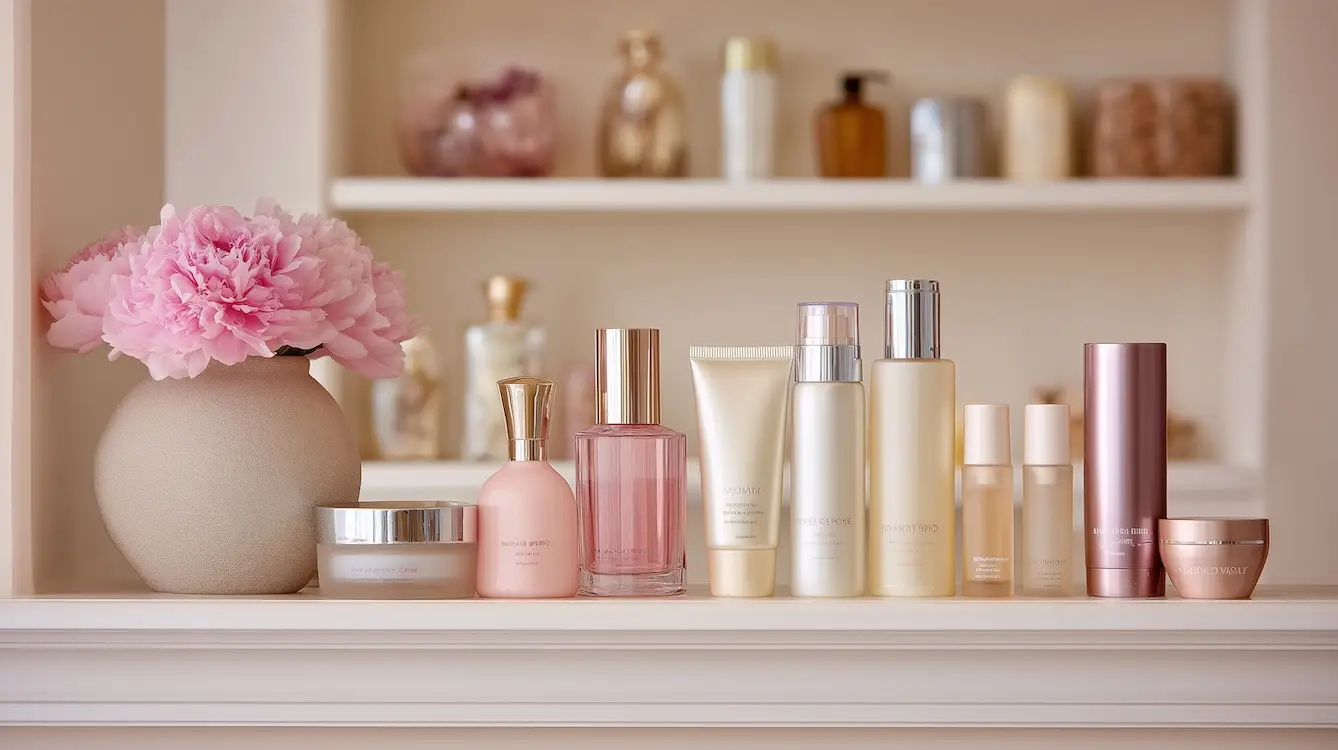A beauty routine isn’t about following trends. It’s about understanding your skin and providing the care it requires at each stage of life. The correct order, ingredients, and consistency make all the difference. You don’t need to follow every step in this guide. Begin with simple routines and gradually add more complexity. A basic skincare routine can be as simple as cleansing, toning, and moisturising. Once that becomes a habit, you can introduce treatments like exfoliants, serums, or masks to meet your skin’s needs.

How to Apply Skincare Products in the Right Order
Applying products in the correct order helps each one work better. The general rule is to start with lighter textures and move to richer ones. Begin with cleansing and toning to prepare the skin, then add serums and moisturisers to treat and hydrate. Sunscreen should always be the last step in the morning to protect against UV damage.
1. Eye Makeup Remover: Gently cleanse mascara, eyeliner, and eyeshadow without rubbing or irritating the delicate skin around your eyes. Seek ingredients such as micellar water, chamomile, cucumber, aloe vera, or argan oil. This step benefits all skin types, especially those with dry or sensitive skin.
2. Cleanser: Use to wash away dirt, oil, and makeup residue, leaving skin refreshed and balanced. Select a formula suitable for your skin type. Gel cleansers are effective for oily or combination skin, while creams and balms are best for dry or sensitive skin. Ingredients such as glycerin, green tea, oat extract, and salicylic acid help cleanse without stripping moisture.
3. Exfoliator: Use two to three times a week to remove dead skin cells and enhance the absorption of other products. Look for gentle exfoliating ingredients such as AHAs, BHAs, PHAs, or fruit enzymes. Adjust the frequency based on your skin’s sensitivity.
4. Face Mask: Use once or twice a week for targeted treatment, whether hydrating, clarifying, or calming. Clay or charcoal masks are suitable for oily or congested skin, while hydrating masks with hyaluronic acid or aloe vera are best suited for dry skin. Exfoliating masks with fruit enzymes or acids help brighten dull complexions.
5. Toner: A toner helps balance your skin’s pH and prepares it for hydration. Choose one with soothing ingredients such as niacinamide, aloe vera, or rosewater. Those with sensitive skin should avoid toners containing alcohol or high levels of witch hazel.
6. Essence: Essences provide a light layer of hydration, allowing serums to absorb more effectively. Look for hyaluronic acid, fermented extracts, or panthenol to plump and smooth the skin.
7. Serums: Serums are concentrated treatments that address specific issues such as dullness, fine lines, or uneven tone. Vitamin C brightens, niacinamide refines texture, hyaluronic acid increases moisture, and retinol or bakuchiol promotes renewal. Peptides also support firmness and elasticity.
8. Spot Treatment: If necessary, apply solely to blemishes to soothe inflammation and prevent breakouts. Ingredients such as salicylic acid, benzoyl peroxide, sulfur, niacinamide, or tea tree oil help reduce redness and accelerate healing.
9. Eye Cream: Eye cream helps keep the under-eye area hydrated and protected, smoothing lines and reducing puffiness. Look for ingredients such as caffeine, peptides, hyaluronic acid, or vitamin E. Apply gently using your ring finger to avoid tugging.
10. Moisturiser: Moisturiser helps trap hydration and strengthens the skin’s protective barrier. Creams rich in ceramides, squalane, panthenol, and shea butter help maintain softness and prevent dryness.
11. Face Oil: Face oils are optional, adding radiance and locking in moisture. Rosehip, jojoba, marula, and argan oil are nourishing options that can be used after moisturiser or mixed with it.
12. Sunscreen: Use only during the day, not at night. Sunscreen is one of the most effective anti-ageing products you can apply. Use it every morning as the final step in your routine. Choose SPF 30 or higher with ingredients such as zinc oxide, titanium dioxide, avobenzone, or vitamin E.
13. Lip Care: Keep your lips soft and smooth with a nourishing balm containing shea butter, beeswax, coconut oil, or vitamin E.
Neck and Décolletage Care: Extend your skincare routine beyond the face to keep these areas firm and hydrated. Ingredients such as peptides, ceramides, hyaluronic acid, and Retinol help maintain elasticity and tone.
14. Overnight Treatments: Night is when your skin repairs itself. Overnight masks hydrate, retinol creams renew, and barrier-repair balms soothe irritation or dryness.
How to Simplify Your Beauty Routine
If skincare feels overwhelming, keep it simple. Begin with three essential steps: cleanse, moisturise, and protect. These alone can make a noticeable difference when done regularly. A gentle cleanser removes impurities, a nourishing moisturiser restores hydration, and daily sunscreen prevents damage. Once your skin feels balanced and healthy, you can start to add more treatments, such as exfoliators, serums, or masks, based on what your skin needs most. The most effective skincare routines are those you can follow consistently every day.
Skincare By Age
Your skin evolves. Adjusting your routine supports maintaining balance, hydration, and a healthy glow.
In your 20s, skin is firm and moisturised, but prevention is key. Develop good habits like cleansing, moisturising, and applying daily SPF. Prioritise hydration and protection. Essential ingredients include Hyaluronic acid, niacinamide, and vitamin C.
In your 30s, cell renewal slows down, and fine lines may start to form. The skin may feel drier or slightly uneven—Prioritise brightening and gentle renewal. Essential ingredients include Vitamin C, AHAs, peptides, and hyaluronic acid.
In your 40s, collagen and elasticity begin to decline, and hormonal changes can impact skin tone and texture. Focus on firming and repairing. Key ingredients include Retinol, ceramides, peptides, coenzyme Q10, and squalane.
In your 50s and beyond (Mature Skin), the skin becomes thinner and drier, with deeper lines and uneven pigmentation. Focus on nourishment, recovery, and barrier support. Key ingredients include retinol or bakuchiol, peptides, ceramides, hyaluronic acid, vitamin C, and coenzyme Q10. Use gentle, hydrating formulas and avoid harsh exfoliants.
Final Notes on Skincare
Healthy skin isn’t about perfection; it’s about consistency, patience, and listening to what your skin needs. Start with the basics: cleanse, moisturise, and protect. As your skin evolves, your routine should adjust accordingly. Whether you’re in your twenties or beyond your fifties, hydration, daily SPF, and gentle care will always be the foundation of radiant, confident skin.
Frequently Asked Questions About Skincare
How do I know if I am using too many skincare products?
If your skin feels tight, red, or irritated, simplify your routine. Too many actives can overload the skin. Return to a basic routine of cleanser, moisturiser, and sunscreen until your skin settles.
What should I do if my skin suddenly breaks out?
Avoid scrubbing or over-cleansing. Use a gentle, fragrance-free cleanser and a spot treatment containing salicylic acid or niacinamide. Keep your routine simple until your skin settles.
Can I skip toner?
Yes, toner is optional. If your cleanser leaves your skin feeling balanced and not tight, you may not need it. Toner is most useful if you enjoy the feeling of extra freshness or want to add mild hydration.
Is it safe to use retinol every night?
Most people should start slowly with retinol, applying it two or three times a week before gradually increasing the frequency. Always apply moisturiser afterwards to reduce irritation and use sunscreen during the day.
How long does it take to see results from skincare?
You may notice smoother, softer skin within a few days, but most ingredients, such as vitamin C, Retinol, or peptides, take four to six weeks to show visible results. Consistency matters more than speed.
Articles we like: The Guardian: How to start a skincare routine, and Glamour Magazine: Best basic skincare routine. You may also like: Ten Ways to Make Mindfulness Part of Your Everyday Life.
